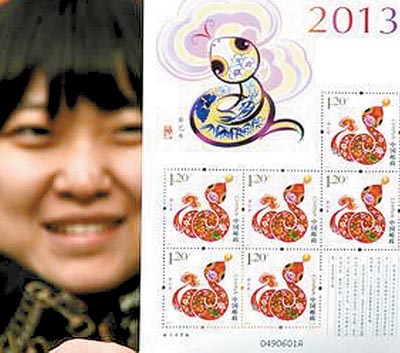|

THE latest zodiac stamp was released across the country recently to celebrate the arrival of the Year of Snake on the Chinese lunar calendar, which begins Feb. 10. The snake depicted on the stamp has been described by stamp collectors and netizens as “cute.”
“It is a design for all Chinese people, so it should be joyful and festive. When I designed the snake, I incorporated many traditional elements and tried to meet the public’s preferences, particularly the tastes of young people. I hope people can feel excite about the arrival of the Spring Festival when they see it,” said Wu Guanying, professor of the information art design department of the Academy of Art & Design at Tsinghua University in Beijing. Wu is also one of the academic consultants of the Shenzhen government.
Snakes are not as well loved as many other animals. They are also difficult to draw because of the shape of their bodies. “In ancient China, a red snake signified good luck, so I decided to use red as the main color. It is also more in keeping with the festive season. When designing the snake, I borrowed many concepts from ancient myths,” he said.
The red snake on the stamp is decorated with peach blossoms in spring, lotus in summer, chrysanthemum in autumn and plum blossoms in winter, representing four lucky and happy seasons.
The snake also has a pearl in its mouth. An ancient Chinese legend tells the story of a snake which carries a bright pearl in its mouth to show its gratitude to the man who saved its life, and Wu drew inspiration from the story. “This was a suggestion given by Ma Weidu, a famous stamp collector. He said that giving a pearl to the snake would give the design more cultural elements,” Wu said. The design also signifies good luck and inspires people to do good deeds and repay other people’s kindness.
There are also two blades of ganoderma grass on the snake’s tail. In China, ganoderma grass symbolizes fortune and prosperity.
When the stamp was released Jan. 5, many netizens praised the design. “Even my students love it. As a teacher, I have more opportunities to get in touch with young people, so it is not very difficult for me to learn about what they like,” Wu said.
As one of the main designers of the mascots of the 2008 Beijing Olympics, Fuwa, and the designer of the mascot of the 2008 Beijing Paralympics, Lele, Wu is an illustrious figure in the design industry.
“But I am still a rookie in stamp design,” Wu said.
Wu made more than 30 versions of the design. He even opened a Sina Weibo account to collect more opinions from netizens. “I posted some of my drafts and the winner was the one that gained the most praise. About 90 percent of the netizens liked it. I feel very proud,” he said.
However, some netizens also said that Wu’s design “borrowed” too many elements from previous Year of Snake stamps. For example, flowers and ganoderma grass can be seen on the first and third snake stamps, while patterns on the snake body are also similar.
“I looked up many files and folk paper-cuts when designing the stamp and they all use these elements. In fact, this is not something that is first created by somebody. It is our traditional culture. It is the design methods that matter,” he said.
(Wang Yuanyuan)
|

